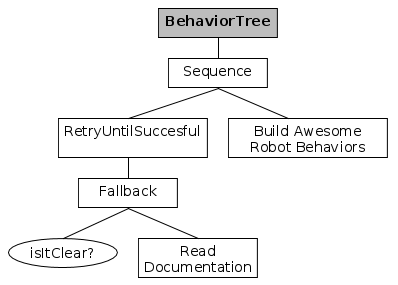This package is a wrapper around the BehaviorTree.cpp v3.8 package. Developed as a general high-level task control architecture for many robotic systems in the Institute for Robotics and Autonomous Systems (IRAS) at University of Applied Sciences Karlsruhe (HKA)
It provides an easy to use API for ROS2 services and actions inside a BehaviorTree action node. Additionally it offers XML palette generation and easierer port handling.
For an example on how to set up a ROS2 project with this BT framework and create custom BT actions look at IRAS_Coordinator
For general informaton of the concept of Behavior Trees read the docs.
This wrapper builds on top of the classes from BehaviorTree.cpp v3.8 and introduces new classes with integrated ROS2 support. Those include:
- RosNode Classic BT StatefulActionNode with access to ROS2 node handle
- RosCondition Classic BT ConditionNode with access to ROS2 node handle
- RosAction Wrapps a ROS2 action client and provides simple interface
- RosService Wrapps a ROS2 service client and provides simple interface
To integrate ROS2 clients into the BT node structure, a Hierarchical Finite State Machine (HFSM) is used. The state machine of a standard BT action is marked in purple. A single BT node is continuously ticked by the root of the tree. First, it initializes in a Start state and results in either Running, Failure or Success. The latter two are terminal states, only in the Running state, the node is ticked again. The method to combine the BT concept with ROS 2 functionalities builds on adding a sub-hierarchical state-machine to the Running state which handles the execution of the ROS 2 action client. This hierarchical level is marked in the figure below with green. This substate machine starts in the Reset state and firstly sends the ROS 2 action goal over the ROS 2 network to the corresponding ROS 2 action server. This action server can accept or reject the requested action goal. Depending on the answer sent back to the action client, the transition accepted or rejected is triggered and either the client continues or the whole BT action fails. All responses from the ROS 2 action server are shown as transitions in blue. Note that during the handling of the action client, the BT node is continuously ticked but remains in the Running state. As a result, the transitions and changes from the ROS 2 action server are only registered in the frequency of the tick source which is per default 100 Hz.
This work is licensed under a Creative Commons Attribution-NonCommercial 4.0 International License.



